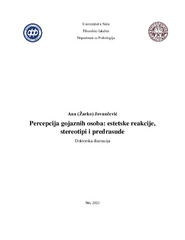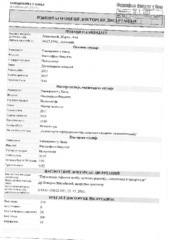Приказ основних података о дисертацији
Percepcija gojaznih osoba: estetske reakcije, stereotipi i predrasude
| dc.contributor.advisor | Milićević, Nebojša | |
| dc.contributor.other | Milenović, Miodrag | |
| dc.contributor.other | Popadić, Dragan | |
| dc.creator | Jovančević, Ana Ž. | |
| dc.date.accessioned | 2023-11-28T21:21:40Z | |
| dc.date.available | 2023-11-28T21:21:40Z | |
| dc.date.issued | 2023 | |
| dc.identifier.uri | http://eteze.ni.ac.rs/application/showtheses?thesesId=8639 | |
| dc.identifier.uri | https://fedorani.ni.ac.rs/fedora/get/o:2079/bdef:Content/download | |
| dc.identifier.uri | https://plus.cobiss.net/cobiss/sr/sr/bib/127693577 | |
| dc.identifier.uri | https://nardus.mpn.gov.rs/handle/123456789/21941 | |
| dc.description.abstract | The aim of this disertation was to examine the role of body self-confidence, BMI, and the tendency towards social desirability as predictors of anti-fat stereotypes and prejudices, and gender, obesity, and social status as moderators of this relationship, as well as eye movements of subjects when observing obese individuals. This was examined through four studies. The results of the first study (N = 311; 60.8% female) suggest that body self-confidence, BMI, and the tendency towards social desirability can predict anti-fat stereotypes and prejudices. Obese female individuals were evaluated most negatively. The second study (N = 241; 64.7% female) indicates that the social status of stimulus individuals is also a significant moderator of the relationships described above. Obese female individuals of low social status are evaluated most negatively. The second research also suggests that stereotypes may not be cognitive precursors of prejudice, as certain theories suggest. The third study (pilot for study 4; N = 148; 80.4% women) indicated that the Cheeks and Mouth region of interest was the best indicator of the presence of obesity in the stimulus. In the fourth study (N = 191; 61.5% women), we obtained information on the following eye movement parameters using the Gazepoint eye tracker: (1) First view, (2) Duration of fixations, (3) Fixations and (4) Revisits. Through the OMRON body composition monitor we collected information about kilograms, and about: (1) Body and (2) Visceral fat, (3) Muscle percentage, (4) Metabolism, and (5) BMI. Eye movement parameters can be predicted by body self-confidence and body condition parameters, while gender and obesity of stimuli are significant moderators in this relationship. We can conclude that obese individuals are perceived differently from non-obese ones, as well as that the parameters related to the body condition of the respondents and body self-esteem can predict anti-fat stereotypes and prejudices. | en |
| dc.format | application/pdf | |
| dc.language | sr | |
| dc.publisher | Универзитет у Нишу, Филозофски факултет | sr |
| dc.rights | openAccess | en |
| dc.rights.uri | https://creativecommons.org/licenses/by-nc-nd/4.0/ | |
| dc.source | Универзитет у Нишу | sr |
| dc.subject | Gojazne osobe, pol, socijalni status, telesno samopuzdanje, BMI, pokreti očiju | sr |
| dc.subject | Obese persons, gender, social status, body self-esteem, BMI, eye movements | en |
| dc.title | Percepcija gojaznih osoba: estetske reakcije, stereotipi i predrasude | sr |
| dc.type | doctoralThesis | |
| dc.rights.license | BY-NC-ND | |
| dc.identifier.fulltext | http://nardus.mpn.gov.rs/bitstream/id/157293/Doctoral_thesis_14472.pdf | |
| dc.identifier.fulltext | http://nardus.mpn.gov.rs/bitstream/id/157294/Jovancevic_Ana_Z.pdf | |
| dc.identifier.rcub | https://hdl.handle.net/21.15107/rcub_nardus_21941 |



